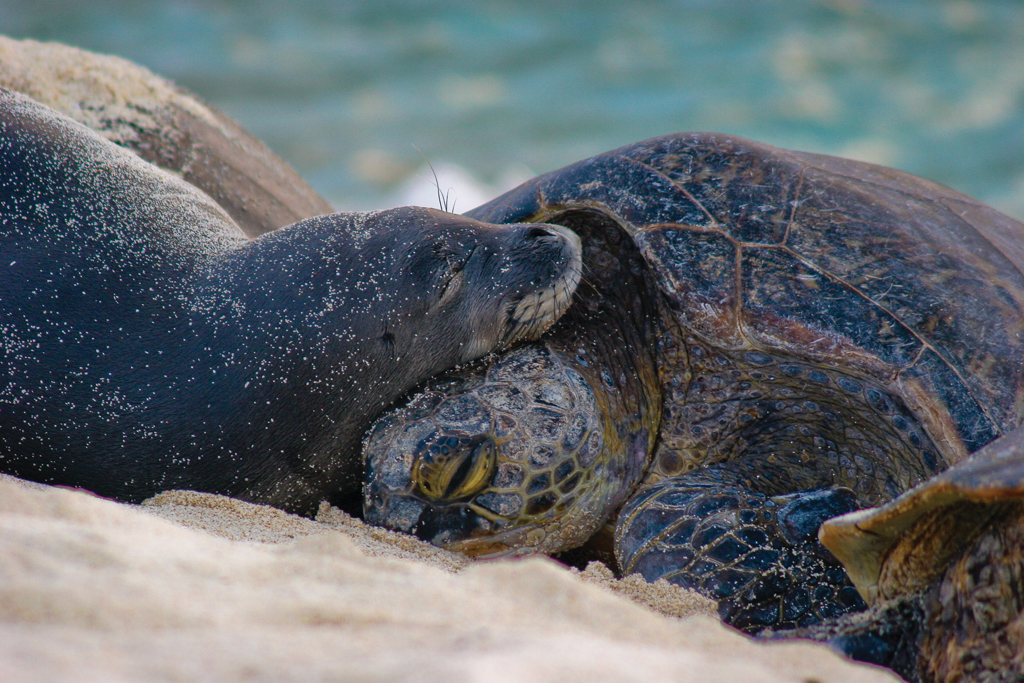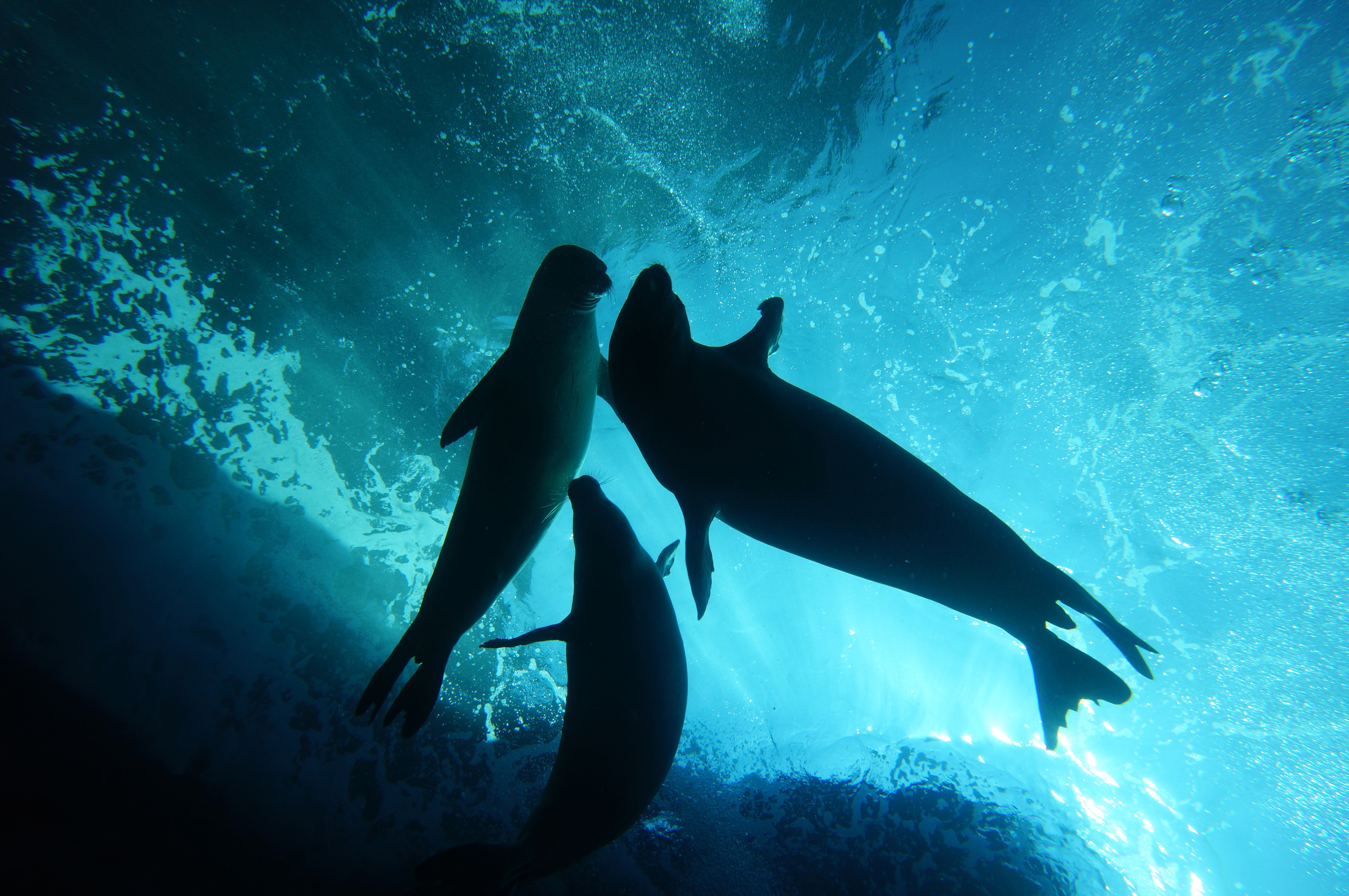2019 Activity Update
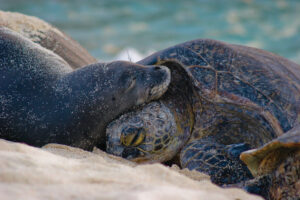 2019 Was The Biggest Year Yet for HMAR
2019 Was The Biggest Year Yet for HMAR
Hawaii Marine Animal Response (HMAR) is the largest Hawaii-based nonprofit marine species conservation and response organization. Now in our 5th year, we work on the islands of Oahu and Molokai with our team of dedicated volunteers, interns and staff that are supported by private donations, corporate funding and government grants.
We focus our efforts on protected marine species in Hawaii that are most likely to be impacted by human-related threats due to their natural behaviors and habitat and the ocean ecosystem these animals call home. These species include the rare and endangered Hawaiian monk seal, threatened green and endangered hawksbill sea turtles and several marine seabird species. Our government partners include the National Oceanic and Atmospheric Administration (NOAA), the U.S. Fish & Wildlife Service and the State of Hawaii.
We work to achieve our mission through activity every day of the year that impacts our three key objectives: (1) growing active and engaged community support, (2) managing and increasing the populations of protected marine species, and (3) saving animals that need help. At HMAR we believe it's important to measure our progress on these three objectives by tracking our "Key Operations Indicators" so we can be confident that our programs are having the largest impact possible.
Thousands of times each year, our field response, outreach, education, escalations, rescue and stranding support activities help us move towards our vision of Hawaii’s ocean ecosystem shared in sustainable harmony by humans and protected marine animals such as Hawaiian monk seals, sea turtles and seabirds.
Here are our Key Operations Indicators for 2019.
- In 2019, we received over 4,150 calls into our hotlines. These calls were to report sightings of protected marine animals, many of which were animals in need of support. This represents a 70% increase in monthly hotline activity since 2016 and shows that our work to raise awareness of protected marine animal issues is having a positive effect. People care more so they call more. To date, we have taken over 12,500 calls on our hotlines.
- HMAR team members were engaged in field related activities more than 5,000 times in 2019. This is a 127% increase in monthly field activity since 2016 and shows we're out there in the field assessing the condition of animals, collecting valuable data and observations for research, monitoring vulnerable animals, looking for animals of concern, finding animals that may have a health problem, and conducting outreach. Since our start, we have conducted over 12,300 field related actions.
- 2019 was a year in which we performed 310 Hawaiian monk seal, sea turtle and seabird escalations, interventions and rescues. This is a 396% increase in monthly activity since 2016 and shows our work is helping to save animals in need. To date, we have engaged in more than 750 animal escalations, interventions, rescues and stranding responses.
- Our volunteers and staff worked over 27,700 hours in 2019. This is a 124% increase in monthly hours since 2016. We're accomplishing more because we are working harder than ever.
- In 2019, our team members engaged in outreach or education activity with members of the public over 108,500 times. This is a 390% increase in monthly outreach and education activity since 2016. We're creating active supporters of our protected marine animals and the ocean ecosystem, and the people we meet are taking actions to help. Since 2016, we have reached over 260,000 people with face-to-face outreach and education.
Help us continue this important work. Donate to our cause or join our volunteer team. Click HERE to learn more.
We thank you for your support!
Toxoplasmosis and Fibropapillomatosis

Unseen Impacts: Toxoplasmosis and Fibropapillomatosis
By Kathleen Barkats
In addition to its beautiful beaches, Hawaii is home to many marine animals. As a visitor or resident, it is common to experience Hawaii’s wildlife, such as sea turtles popping their heads up from the water and Hawaiian monk seals resting on the beach. Unfortunately, marine species like these face many environmental threats including debris entanglement, physical trauma, habitat loss, and many more. These important issues come to the forefront of environmental discussion because of how broadly they impact the oceans. However, there exist lesser-known issues that pose particular threats to specific species. For the Hawaiian monk seal, Neomonachus schauinslandi, toxoplasmosis is a life-threatening disease. Fibropapillomatosis is the similar disease for green sea turtles, Chelonia mydas. Human activity is likely perpetuating these diseases, which pose serious threats to both species.
Toxoplasmosis is a parasite spread by cats, the only definitive hosts (Dubey 2016). This disease can be transmitted to humans also, and is a primary concern for pregnant women where the disease can cause birth defects. In the marine environment, toxoplasmosis can impact marine mammals such as the endangered Hawaiian monk seal and dolphins.
Toxoplasmosis spreads through a specific sequence of events. The parasite is present in intermediate hosts like mice and birds and it is passed on to animals that consume these hosts. When cats predate these intermediate hosts, they consume parasitic cysts and become infected. Toxoplasmosis reproduces exclusively within cats, who shed the oocysts (the egg form of a parasite) through their feces and spread the parasite throughout the environment. Toxoplasmosis oocysts work their way into waterways that feed into the ocean. As a result, Hawaiian monk seals and dolphins can ingest the parasite through consumption of prey in the marine ecosystem.
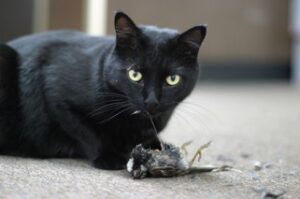 Toxoplasmosis is a major cause of death in Hawaiian monk seals in the main Hawaiian Islands. It has killed at least eight animals since 2001 (NOAA 2018) and this is very significant given the small remaining population of these endangered animals. According to the Center for Disease Control, symptoms in humans generally present as flu-like, although some infections remain asymptomatic. As such, the disease is difficult to detect and treat in any species. Seals with toxoplasmosis can face impaired reproductive, brain, and immune system functions (NOAA 2019). Animals that do not die from the disease become much more vulnerable to natural environmental stressors.
Toxoplasmosis is a major cause of death in Hawaiian monk seals in the main Hawaiian Islands. It has killed at least eight animals since 2001 (NOAA 2018) and this is very significant given the small remaining population of these endangered animals. According to the Center for Disease Control, symptoms in humans generally present as flu-like, although some infections remain asymptomatic. As such, the disease is difficult to detect and treat in any species. Seals with toxoplasmosis can face impaired reproductive, brain, and immune system functions (NOAA 2019). Animals that do not die from the disease become much more vulnerable to natural environmental stressors.
There is an incredibly large population of feral cats in Hawaii and these animals rapidly spread toxoplasmosis oocytes throughout the environment. To reduce this impact, humans should avoid feeding and interacting with feral cats as it supports the population. Instead, opt for environmentally safer alternatives like catch and release sterilization, adoption and broader feral cat management strategies. In the same vein, domesticated cats must stay indoors unless supervised. Outdoor cats can unfortunately put the lives of native fauna, like seabirds, at stake. Some countries with problematic feral cat populations, such as Australia and New Zealand, have introduced eradication operations to minimize damage to native ecosystems.
While monk seals struggle with toxoplasmosis, sea turtles face Fibropapillomatosis (FP), which is a viral infection. Both green sea turtles (honu) and hawksbill sea turtles (‘ea) live in Hawaii, with hawksbill turtles being very endangered. While HMAR responds more often to green sea turtles affected by FP, all turtle species are vulnerable to its impacts. FP is presumed to be a strain of herpes; however, there is no substantial evidence to support this theory other than the quick spreading of the virus and the fact that there is no known cure (Whitehouse 2015).
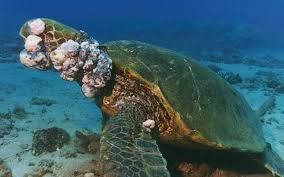 Fibropapillomatosis presents as tumors that appear on the faces, bodies, and vital organs of sea turtles. Because not all tumors are visible to the naked eye, it can be impossible to tell if green sea turtles are infected. Those with external tumors can have impaired vision or mobility, putting them in danger in the surrounding environment, while internal tumors can impair the function of vital organs. Individuals can die from these tumors whether they are internal or external, and attempts to remove tumors often become thwarted by recurrence. Humans do not yet have a clear understanding of how this disease spreads. Research from the University of Hawaii at Manoa indicates that nitrogen runoff in the nearshore ecosystem could be linked to tumor growth. Nitrogen increases the amount of the amino acid arginine in invasive algae and seaweed, which are staples in the sea turtle diet. Studies show that arginine actually promotes the FP virus (Smith and Zimmerman 2014). Chris Whitehouse proposes another theory in his 2015 overview of FP. He suggests that FP could be transmitted between honu through direct contact of uninfected turtles with infected turtles, although there is no certain conclusion.
Fibropapillomatosis presents as tumors that appear on the faces, bodies, and vital organs of sea turtles. Because not all tumors are visible to the naked eye, it can be impossible to tell if green sea turtles are infected. Those with external tumors can have impaired vision or mobility, putting them in danger in the surrounding environment, while internal tumors can impair the function of vital organs. Individuals can die from these tumors whether they are internal or external, and attempts to remove tumors often become thwarted by recurrence. Humans do not yet have a clear understanding of how this disease spreads. Research from the University of Hawaii at Manoa indicates that nitrogen runoff in the nearshore ecosystem could be linked to tumor growth. Nitrogen increases the amount of the amino acid arginine in invasive algae and seaweed, which are staples in the sea turtle diet. Studies show that arginine actually promotes the FP virus (Smith and Zimmerman 2014). Chris Whitehouse proposes another theory in his 2015 overview of FP. He suggests that FP could be transmitted between honu through direct contact of uninfected turtles with infected turtles, although there is no certain conclusion.
Unlike toxo, FP proves more challenging to prevent. According to the US Army Medical Research Institute of Infectious Disease, FP prevalence was diminished by the removal of infected animals in some areas of Hawaii. Sea turtles usually inhabit near-shore environments where pollution and runoff are often greatest. By cleaning coastal waterways and shorelines, or supporting regulation of permitted runoff, we might reduce pathogens that can cause FP to develop in the first place. In addition, reporting sightings of injured or infected sea turtles help HMAR and NOAA keep track of the prevalence and spread of this disease.
Sea turtles and Hawaiian monk seals are keystone species, so toxoplasmosis and FP impact the function of the wider Hawaiian marine ecosystem. Both are particularly susceptible to pathogens in the oceans and help indicate the health of ocean environments. Thus far, these diseases have been nearly impossible to eliminate, so humans must take preventative action to minimize the contribution to these deadly diseases. Becoming informed of the issues facing monk seals and sea turtles helps us understand the impacts of our daily choices. Supervising pets, minimizing pollution, and reporting distressed marine animal sightings are significant forms of assistance. These small adjustments bring us closer to allowing monk seals and sea turtles to thrive in the generations to come.
Escalations & Rescue Examples
 Some Examples of Recent Escalations & Rescues
Some Examples of Recent Escalations & Rescues
 Sea Turtles: While green sea turtles spend most of their time around rocks and reefs deftly avoiding running into these structures, every once in a while, one gets stuck. Recently, HMAR responded to a report of a large 3-foot-long turtle lodged in the reef on the north shore of Oʻahu. Most of the time the turtles are not stuck - they are just basking or foraging - however after our hotline operator gathered all the necessary information from the caller, it became obvious from the photos that the animal was lodged in a crevasse and unable to free itself. When our rescue responder arrived on the scene, we were able to dislodge the animal from the spot but a wave pushed it right back in. In order for us to free the animal, we would have to completely remove it from the reef and move the animal away from the crevasse. Luckily for us, a wave helped us free the animal! We got it out and moved it about 5 feet away from where it was so it could safely re-enter the water. Many thanks to our HMAR rescue responder who was able to help this turtle!
Sea Turtles: While green sea turtles spend most of their time around rocks and reefs deftly avoiding running into these structures, every once in a while, one gets stuck. Recently, HMAR responded to a report of a large 3-foot-long turtle lodged in the reef on the north shore of Oʻahu. Most of the time the turtles are not stuck - they are just basking or foraging - however after our hotline operator gathered all the necessary information from the caller, it became obvious from the photos that the animal was lodged in a crevasse and unable to free itself. When our rescue responder arrived on the scene, we were able to dislodge the animal from the spot but a wave pushed it right back in. In order for us to free the animal, we would have to completely remove it from the reef and move the animal away from the crevasse. Luckily for us, a wave helped us free the animal! We got it out and moved it about 5 feet away from where it was so it could safely re-enter the water. Many thanks to our HMAR rescue responder who was able to help this turtle!
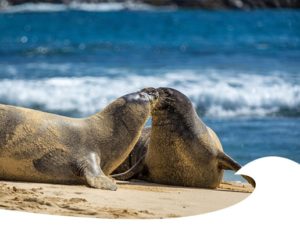 Hawaiian Monk Seals: One of the problematic threats for Hawaiian monk seals, sea turtles and seabirds is entanglement in fishing gear such as fishing line, hooks, and nets (Boland and Donahue, 2003). One of the Hawaiian monk seals we see regularly on Oʻahu had such an encounter earlier this year. A sub-adult female seal named RH48 “Lei Ola” showed up hooked on the west side of Oʻahu. She had a superficial hook but was dragging some fishing line behind her. We, and our partners at NOAA, were concerned about the fishing line as this could present an entanglement hazard, so NOAA attempted an intervention to trim the line but this was unsuccessful. HMAR then started escalated surveys for this animal along many miles of shoreline for many hours each day. This continued for several days and twice again an intervention was attempted but was unsuccessful. We continued our daily surveys and many days later we were happy to find this animal without a hook. At some point during the days we were looking for the animal, she had thrown the hook on her own. HMAR is regularly engaged in escalations regarding Hawaiian monk seals. It’s part of the important work we do to help this and other vulnerable species.
Hawaiian Monk Seals: One of the problematic threats for Hawaiian monk seals, sea turtles and seabirds is entanglement in fishing gear such as fishing line, hooks, and nets (Boland and Donahue, 2003). One of the Hawaiian monk seals we see regularly on Oʻahu had such an encounter earlier this year. A sub-adult female seal named RH48 “Lei Ola” showed up hooked on the west side of Oʻahu. She had a superficial hook but was dragging some fishing line behind her. We, and our partners at NOAA, were concerned about the fishing line as this could present an entanglement hazard, so NOAA attempted an intervention to trim the line but this was unsuccessful. HMAR then started escalated surveys for this animal along many miles of shoreline for many hours each day. This continued for several days and twice again an intervention was attempted but was unsuccessful. We continued our daily surveys and many days later we were happy to find this animal without a hook. At some point during the days we were looking for the animal, she had thrown the hook on her own. HMAR is regularly engaged in escalations regarding Hawaiian monk seals. It’s part of the important work we do to help this and other vulnerable species.
These two stories are just examples of the many interventions, escalations, rescues and stranding responses we are involved in regularly. During 2019, we performed 310 of these operations to help sea turtles, Hawaiian monk seals and seabirds. With your help, we can continue this important work. Please donate or choose other ways to help by clicking HERE.
Mahalo for your support!
Rare Birds News
 Rare Birds Could Be Making Oahu Home Once Again
Rare Birds Could Be Making Oahu Home Once Again
by Christine Tarski
Hundreds of years ago, the Newell's Shearwater, ‘a’o, were abundant, thriving, and flying over the waters surrounding all the main Hawaiian Islands. Uncovered fossils show that large colonies of these birds were established in the middle and higher levels of highly vegetated mountain peaks. Native Hawaiians hunted the birds extensively on Oahu to the point that there were no remaining birds left in the beginning of the 1800’s when Europeans began moving to the islands. With the introduction of invasive owls, cats, mongoose, pigs, and rats on other islands, the ‘a’o population was further decreased.
Although they were once believed extinct, important new research suggests ‘a’o may be living and breeding on Oahu. Established as a new species in 1900, the ‘a’o were sadly declared extinct in 1908, but were amazingly rediscovered at sea in 1947. Biologists were thrilled to find breeding pairs on Kaua’i in 1967. In the 1990’s, ‘a’o’ numbers were estimated at 20,000 breeding pairs. ‘A’o’s are nocturnal and make nesting areas by burrowing into sheer mountain cliffs covered with dense vegetation. These two facts made studying the remaining birds very difficult.
We know that ‘a’o’s lay a single egg around June, which is incubated by both parents. Once the chick hatches, both parents continue to care for and feed the chick collaboratively. Parents may fly hundreds of miles and return at night to feed the chick. By November, the chick fledges and is on its own.
In the fall of 1992, Hurricane Iniki wiped out many of the chicks who were close to fledging. Further decrease in the population of these seabirds has resulted from predators, light pollution, collision with power lines/wind turbines, habitat loss, and possible disease.
‘A’o’s are now considered classified as threatened by both state and federal governments. Breeding colonies are mainly on Kaua’i, with smaller colonies on Hawai’i, Lehua and Molokai. ‘A’o’s have been seen on other islands occasionally, including Oahu, but were considered birds that were thrown off course by storms or confused by city light pollution.
Since the 1990’s, numerous groups have been working to implement conservation measures. These measures include hooding all street lights on Kaua’i and reducing resort lighting, initiating and increasing predator controls, and establishing native plant life in nesting areas.
For the U.S. Fish and Wildlife Service (USFWS) recovery action planning, Pacific Rim Conservation’s Lindsay Young conducted a statewide survey of several seabirds, including ‘a’o’s, during 2016-2017. Her team used acoustic recorders, putting the devices in very remote high mountainous areas, sometimes using helicopters, sometimes climbing and scaling dangerously steep crags. Although Oahu was not included in the islands to survey, Young, who lives on Oahu, decided to place recorders in 15 places on this island.
Her team was very excited to hear calls of the ‘a’o over the two years of recording. ‘A’o were heard at two places on Oahu: one was on the leeward slopes of Mount Kaala in the Waianae Mountains and another at Poamoho in the Koolau Mountains.
Although there could be nesting colonies on Oahu, Young feels these also could be “young birds from other islands that are searching for mates and breeding sites. Either way, it gives us hope that we will be able to … attract them to nest on an island where they were once abundant.”
So, how do you and I recognize these once extinct birds? ‘A’o or Newell’s Shearwater are highly pelagic (on the open ocean) throughout the year. From April through November, ‘a’o’s can be seen in the Hawaiian Islands. The rest of the year, they take to the tropical ocean, as far west as the Mariana Islands and as south as Samoa. They are 13” in length with a wingspan of 8.8 - 9.8”. Both male and females are a very dark brown above with a white throat and underparts. Their bill is also dark with a hooked tip while the legs and feet are pink. When seen flying, these birds fly fast and low over the water with rapid wing beats and fewer glides.
‘A’o’s will dive into the ocean and actually swim down to 30’ with their wings partially folded to catch their prey. They gather with other seabirds and look for schools of tuna. The tuna drive smaller fish and squid to the surface where the ‘a’o’s happily feed. Their call, usually only heard in nesting areas, sounds like a donkey braying.
As well as watching the ocean for seals, sea turtles, whales and dolphins, be sure to also look up to the sky, and keep your binoculars ready. You could very well spot an ‘a’o for yourself.
Hawaii Marine Animal Response (HMAR) is a first responder for Hawaiian monk seals and sea turtles on Oahu and we also handle rescues and transport for seabirds that may need assistance. If you see a seabird that may need help, please call our hotline at (808) 687-7900. If you see a marine mammal or sea turtle of concern, please call us (888) 256-9840. Learn more about HMAR, Hawaii’s protected marine animals and how you can help HERE.
Corporate Sponsor Programs
Hawai’i Marine Animal Response (HMAR) Corporate Sponsorship Programs
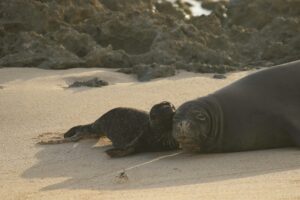 It takes a lot to run our field outreach, rescue, education, marine debris, and stranding response programs. We work hard to cover our costs through grants and private donations, but we still need help. We’re looking for business partners and sponsors to support our ongoing work and help us make an even bigger impact on the protected marine animals and the ocean ecosystem we all love. Whether your organization shares a beach with resting monk seals or your guests come back year after year to enjoy seeing sea turtles and seabirds, this is an opportunity to directly support the conservation of these important animals.
It takes a lot to run our field outreach, rescue, education, marine debris, and stranding response programs. We work hard to cover our costs through grants and private donations, but we still need help. We’re looking for business partners and sponsors to support our ongoing work and help us make an even bigger impact on the protected marine animals and the ocean ecosystem we all love. Whether your organization shares a beach with resting monk seals or your guests come back year after year to enjoy seeing sea turtles and seabirds, this is an opportunity to directly support the conservation of these important animals.
Your organization or business can play an important role in helping HMAR in our mission of helping Hawai’i’s protected marine animals and our shared ocean ecosystem. We offer several different sponsorship programs, or we can customize a program especially for you. HMAR sponsorship begins with a minimum annual donation of $200 or more in cash or in-kind donations of products or services. Donations can be made in a single transaction or provided through an easy monthly installment plan.
Sponsorship benefits include:
- Positive community awareness of your proactive preservation and stewardship efforts.
- Employee participation in HMAR conservation efforts.
- Employee or member education through our Hawai’i Marine Stewards program (see below).
- A package of exclusive, high-value rewards that include brand alignment and media exposure.
Interested in becoming a Sponsor?
Below you’ll find an outline of the different packages we offer to supporting organizations who support HMAR annually at various levels. Your contribution can be financial, in-kind, or a combination of both. You can choose one of the programs below or we can customize a program for you based on your interests, financial commitment level and other factors. Please take the next step in becoming a HMAR sponsor by sending us an email by clicking HERE.
 Platinum Level Sponsor
Platinum Level Sponsor
This sponsorship level is tied to a commitment to provide financial and/or in-kind sponsorship at a minimum of $50,000 per year. The Platinum Level Sponsorship includes:
- Line of business exclusivity with right to veto competitors who are prospective Platinum, Gold, or Silver sponsors.
- Press Release, Facebook and Instagram announcement.
- License to use HMAR logo for use on web, marketing and other promotional materials.
- License to use selected HMAR images and videos for events or social media posts.
- Name and logo recognition positioning on HMAR “Platinum Sponsors” webpage with live link to the sponsor’s URL.
- Framed and signed artist print for a location of your choice.
- HMAR website footer logo recognition.
- Placement on HMAR supporters page with live link to sponsor’s URL.
- Sponsor logo at the end of HMAR videos.
- Sponsor logo recognition/signage at HMAR field response locations (subject to response conditions).
- Sponsor logo placement at outreach tables at community and school events.
- Placement on HMAR Facebook Page on cover image
- Name and logo placement in HMAR email newsletter.
- Name and logo placement on HMAR staff email signatures.
- Name and logo placement on HMAR staff business cards and letterhead.
- Name and logo placement in public advertising and awareness campaigns, including banners and flyers.
- All the benefits of the Hawai’i Marine Stewards program (see below) and up to 2 free Hawai’i Marine Stewards annual employee training events.
- Up to 2 of your team members can participate in a “ride-along” with HMAR field response staff during a 4-hour shift. (This is a great employee recognition gift.)
- Planning and execution of two activities for up to 50 sponsor staff and/or sponsor invitees (coordination and planning is covered, but hard costs apply for transport/food), such as:
- “Pup Prep” cleanup on beaches where monk seals typically give birth
- “VIP Pup Picnic” at a safe distance from a new pup and mom
- Mural painting party with local artist (subject to availability of appropriate wall)
- Opportunity to provide sponsor marketing materials, run competitions, or provide giveaways at events.
- Opportunity to provide co-branded merchandise for our team members to wear during media appearances, beach cleanups, and education/outreach events (hats, reusable water bottles, T-shirts, etc.).
- Opportunity to provide sponsor marketing materials, run competitions, or provide giveaways at events.
- Additional partnership opportunities possible.
 Gold Level Sponsor
Gold Level Sponsor
This sponsorship level is tied to a commitment to provide financial and/or in-kind sponsorship at a minimum of $25,000 per year. The Gold Level Sponsorship includes:
- Press Release, Facebook and Instagram announcement.
- License to use HMAR logo for use on web, marketing and other promotional materials.
- License to use selected images and videos for events or social media posts
- License to use selected HMAR images and videos for events or social media posts.
- Name and logo recognition positioning on HMAR “Gold Sponsors” webpage with live link to the sponsor’s URL.
- Framed and signed artist print for location of your choice.
- HMAR website footer logo recognition.
- Placement on HMAR supporters page with live link to sponsor’s URL.
- Logo at the end of HMAR videos.
- Logo recognition/signage at HMAR field response locations (subject to response and other conditions).
- All the benefits of the Hawai’i Marine Stewards program (see below) and up to 2 Hawai’i Marine Stewards annual employee training events.
- Up to 2 of your team members can participate in a “ride-along” with HMAR field response staff during a 4-hour shift. (This is a great employee recognition gift.)
- Planning and execution of two activities for up to 25 sponsor staff and/or sponsor invitees (coordination and planning covered, but hard costs apply for transport/food), such as:
- “Pup Prep” cleanup on beaches where monk seals typically give birth
- “VIP Pup Picnic” at a safe distance from a new pup and mom
- Mural painting party with local artist (subject to availability of appropriate wall)
- Opportunity to provide marketing materials, run competitions, or provide giveaways at events.
- Further opportunities to be discussed.
 Silver Level Sponsor
Silver Level Sponsor
This sponsorship level is tied to a commitment to provide financial and/or in-kind sponsorship at a minimum of $10,000 per year. The Silver Level Sponsorship includes:
- Press Release, Facebook and Instagram announcement.
- License to use HMAR logo for use on web, marketing and other promotional materials.
- License to use selected images and videos for events or social media posts
- License to use selected HMAR images and videos for events or social media posts.
- Name and logo recognition positioning on HMAR “Silver Sponsors” webpage with live link to the sponsor’s URL.
- Framed and signed artist print for location of your choice.
- Supporters page with live link to specified URL.
- Logo at the end of selected HMAR videos.
- All the benefits of the Hawai’i Marine Stewards program (see below) and up to 2 Hawai’i Marine Stewards annual employee training events.
- Up to 2 of your team members can participate in a “ride-along” with HMAR field response staff during a 4-hour shift. (This is a great employee recognition gift.)
 Supporter Level Sponsor
Supporter Level Sponsor
This sponsorship level is tied to a commitment to provide financial and/or in-kind sponsorship of a minimum of $1,000 per year. The Supporter Level Sponsorship includes:
- Press Release, Facebook and Instagram announcement.
- License to use HMAR logo for use on web, marketing and other promotional materials.
- License to use selected images and videos for events or social media posts
- Name and logo recognition positioning on HMAR “Supporters” webpage with live link to the sponsor’s specified URL.
- All the benefits of the Hawai’i Marine Stewards program (see below) and 1 Hawai’i Marine Stewards annual employee training events.
- Up to 2 of your team members can participate in a “ride-along” with HMAR field response staff during a 4-hour shift. (This is a great employee recognition gift.)
Hawai’i Marine Stewards
Enjoy valuable benefits for your organization while helping Hawai’i’s marine protected species and our shared ocean ecosystem. This sponsorship level is tied to a commitment to provide financial sponsorship of a minimum of $200 per year. Your business or organization can get involved in HMAR’s Hawai’i Marine Stewards program and make a direct impact on helping Hawai’i’s marine protected species and the ocean. We will visit your business or organization (physically or virtually based on your needs) and teach your team about the animals we work with and how you can help them. Your team will be trained by HMAR on the right conservation messaging to share with customers and the public to make sure everyone is part of supporting our ocean. When you become a Hawai’i Marine Steward, here is what you get:
- Free training for your team members (up to 20 people) to learn about Hawai’i’s marine species and how to help in their conservation.
- Window clings to display at your location or on your vehicle.
- Hawai’i Marine Stewards digital logo files to use In your materials, website, and social media.
- Up to 2 of your team members can participate in a “ride-along” with HMAR field response staff during a 4-hour shift. (This is a great employee recognition gift.)
- Your organization name and logo will appear on our HMAR Hawai’i Marine Stewards web page with a link to your web page.
- Your organization will be highlighted periodically in our Hawai’i Marine Stewards Facebook posts, reaching thousands of people.
More information about our Hawai’i Marine Stewards program and the benefits you’ll receive is available by going to the “Hawai’i Marine Stewards” tab on THIS PAGE.
Won’t your organization help us to continue and to expand our important work? If you can, please email us by clicking HERE.
Mahalo for your support!
Videos
HMAR Videos in the Field
HMAR Educational Videos
Never miss a video by subscribing to our Youtube Channel.
More Videos
Relax and enjoy the beauty of a Hawaiian monk seal swimming in waters off of Oahu, Hawaii.
